Professional Blacksmith Tongs Types and Uses
Abana Chapter
February 07, 2024
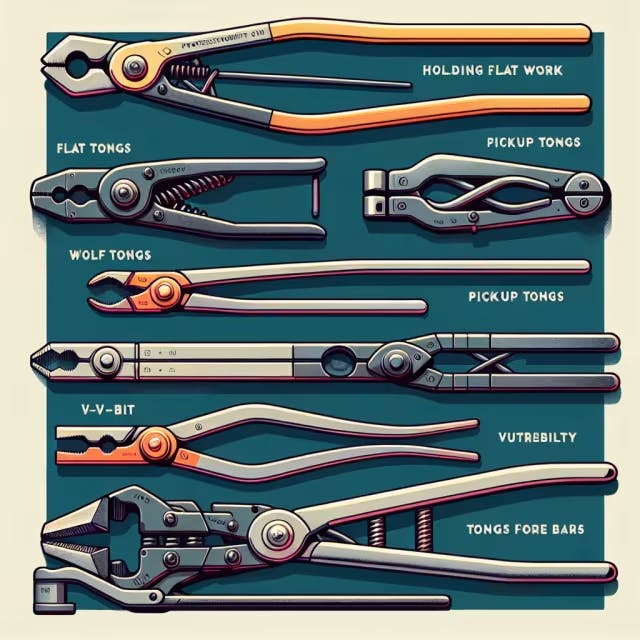
Aspiring and seasoned smiths alike recognize that hammers and anvils are just the beginning when setting up a capable home forge. In a recent exploration of essential blacksmith tools, attention was drawn to the critical role of various tongs in professional blacksmithing—an indispensable instrument for gripping and manipulating hot metals of diverse shapes and sizes. This article delves into the myriad of professional blacksmith tongs types and uses, offering insights to guide both newcomers and veterans in selecting the right tools for their metalwork projects, ensuring precision, safety, and craftsmanship in every heated encounter with steel.
Key Takeaways
Blacksmith tongs are vital for safely gripping and manipulating hot metals in various shapes and sizes.
There is a wide array of tong types, each designed for specific tasks and metal forms, which professionals need to be familiar with to choose the right tool for the job.
The choice of tongs can greatly influence the precision, safety, and overall craftsmanship of the blacksmith's work.
Effective metalwork requires not only skill but also the right selection of tongs to handle different tasks and materials efficiently.
Regular maintenance of blacksmith tongs is essential for ensuring their longevity and functionality in the forge.
Newcomers to blacksmithing, as well as seasoned professionals, benefit from understanding the diverse uses and proper care of tongs to enhance their metalworking projects.
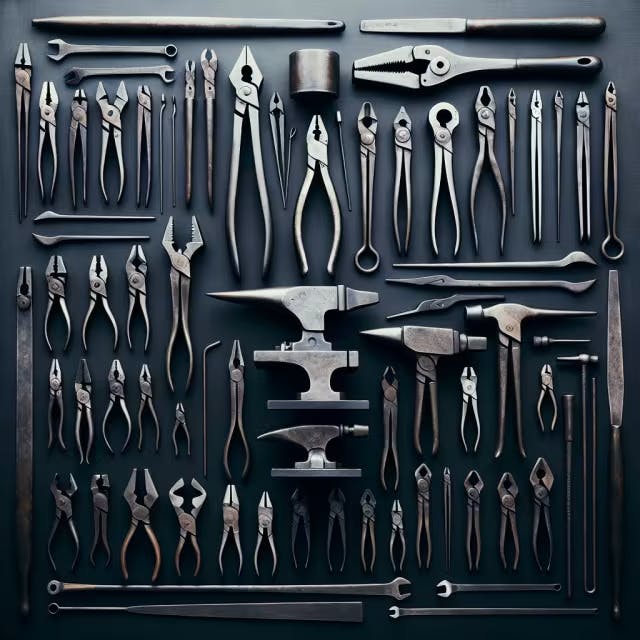
Different Types of Blacksmith Tongs: A Comprehensive Guide
Blacksmith tongs are a crucial tool in the forge, designed ergonomically to hold hot metals securely while they're hammered, cut, or shaped. There's a variety of tongs, each tailored for specific tasks or metal sizes. Here's an overview of common tongs:
Flat Tongs: Ideal for gripping large, flat pieces of metal. They have broad and flat jaws, which provide a stable grip without marking the metal. (Source)
Wolf Jaw Tongs: Known for their versatility. They feature multiple gripping points of different sizes within the same pair of jaws. This allows them to hold various shapes and sizes of metal without the need for frequent tool changes. (Source)
V-Bit Tongs: They have v-shaped jaws that are excellent for gripping round, square, or flat stock. The V-bit design provides a secure grip on the metal and can be used for a variety of tasks.
Blade Tongs: These tongs are specifically designed for bladesmithing. They securely hold the blade, allowing for more detailed work without risking the integrity of the blade's shape. (Source)
Scroll Tongs: Scroll tongs have narrow, tapered, and sometimes curved jaws, making them perfect for intricate work such as creating scrolls or bending small metal pieces.
Punch Tongs: These tongs are designed to hold a punch or chisel while it's being struck with a hammer, providing the necessary control and safety.
Here is a quick reference table summarizing the types of tongs and their uses:
Tong Type | Best Use |
Flat Tongs | Large, flat metal gripping |
Wolf Jaw Tongs | Versatile gripping of varied metal shapes |
V-Bit Tongs | Round, square, or flat stock gripping |
Blade Tongs | Bladesmithing tasks |
Scroll Tongs | Creating scrolls or intricate bends |
Punch Tongs | Holding punches and chisels |
The key to maximizing efficiency and maintaining safety in blacksmithing is choosing the right type of tongs for the job at hand. Utilizing the correct tongs not only prevents accidents but also ensures precision in the craftsmanship of metal works.
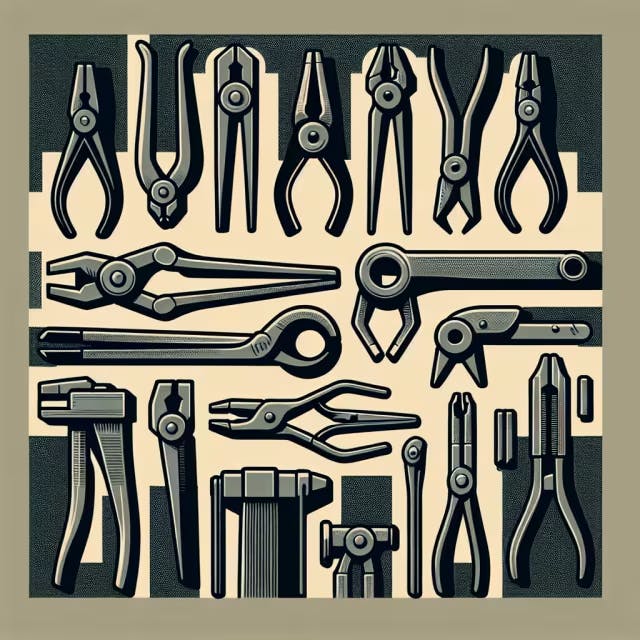
Essential Uses of Professional Blacksmith Tongs
Professional blacksmiths require a variety of tongs to manage the diverse tasks and materials within their trade. Each type is crafted for a specific purpose to enhance efficiency and safety. Here are some common tongs used in blacksmithing and their primary functions:
Type | Description |
Flat Jaw Tongs | Ideal for grasping flat stock and sheets of metal, providing a stable grip. |
Wolf Jaw Tongs | Versatile design capable of holding various shapes including round, flat, and square stock. |
Box Jaw Tongs | Feature a boxed end for securely holding onto square and rectangular pieces. |
V-bit (or Bolt) Tongs | Designed with a V-shaped jaw to grip round stock, such as bolts and rods, firmly. |
Round-Nosed Tongs | Useful for creating loops and spirals in metalwork, offering a smooth curve. |
Duckbill Tongs | The wide, flat jaws are perfect for manipulating wider metal sheets without marring. |
Scroll Tongs | With narrow, tapered jaws, these are used for intricate scrollwork handling. |
Each of these tools enables the blacksmith to execute their craft with precision. For example, when dealing with delicate scroll work, precision is key, which is why scroll tongs are favored for their control and maneuverability about delicate curves. On the other hand, heavy and thick stock requires the robust grip of box jaw tongs that cradle the workpiece, preventing awkward slippage that can lead to accidents or damage.
Selecting the right tongs is crucial for various tasks—whether it's bending and shaping metal, forging intricate designs, or simply transferring hot materials from forge to anvil. Advanced techniques may demand specialized tongs, enhancing the artisanal process which cannot be underestimated. Understanding the applications of each type equips craftsmen to achieve the best results and underscores the importance of using the appropriate tool for each job.
For more detailed insights on the design and utilization of each type of tong, as well as their specific use cases within the realm of blacksmithing, resources like The Crucible's guide on blacksmithing tools provide a wealth of knowledge, sharing the expertise of seasoned professionals in the field.
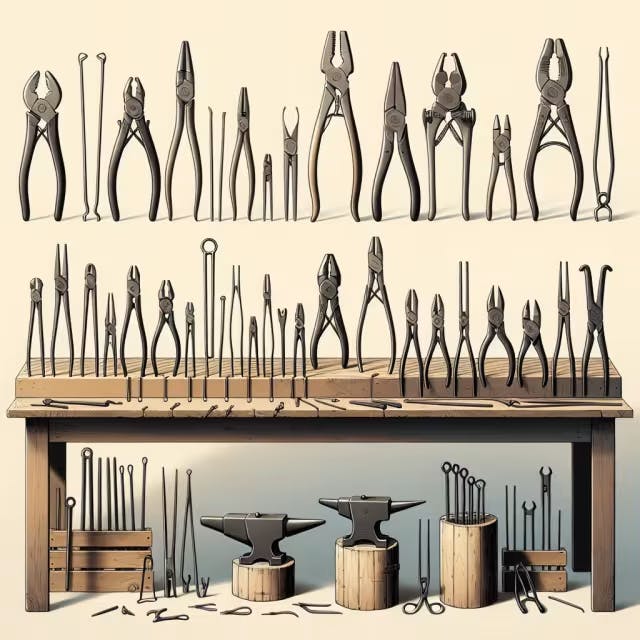
Selecting the Right Tongs for Your Blacksmithing Project
Blacksmith tongs are quintessential tools in any blacksmith's kit, enabling the handling of hot metals with precision and safety. Each type is designed for a specific function, so understanding the different styles and their purposes is key to effective metalwork.
Flat Tongs: Perfect for gripping and holding sheets of metal, their flat gripping surfaces provide a stable hold.
Wolf Jaw Tongs: Versatile and adaptable, with multiple gripping surfaces, they are excellent for holding various shapes including flat, square, and round stock.
Blade Tongs: Designed specifically for bladesmithing, they have a unique shape that secures blades effectively during the forging process.
V-Bit Bolt Tongs: These are great for holding onto square and round stock securely. Their V-bit design clamps around the object, allowing a stable grip that doesn't easily slip.
Scroll Tongs: With a unique tip design suited for scroll work, they enable blacksmiths to create decorative spiral patterns in metal.
Round Tongs: Ideal for handling round objects such as rods and pipes, the circular jaws fit snugly around cylindrical shapes.
Here is a quick reference table for the common types of blacksmith tongs and their primary uses:
Tong Type | Use |
Flat Tongs | Gripping flat sheets of metal |
Wolf Jaw Tongs | General use for multiple shapes |
Blade Tongs | Securing blades during forging |
V-Bit Bolt Tongs | Holding square and round stock |
Scroll Tongs | Manipulating metal into spiral shapes |
Round Tongs | Holding round objects like rods and pipes |
Selecting the correct tongs is crucial for blacksmithing endeavors — a mismatched tong can result in poor control and hazardous situations. Utilizing the right tongs not only ensures the blacksmith's safety but also enhances the quality of the finished work.
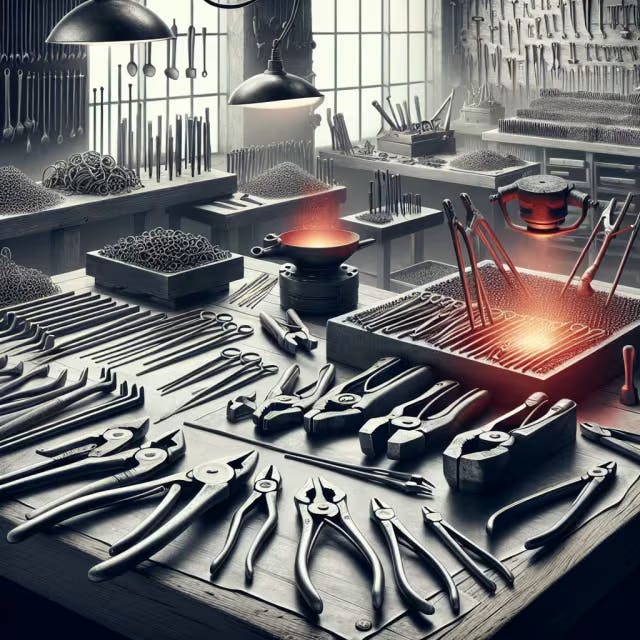
The Role of Tongs in Effective Metal Work
Blacksmith tongs are a crucial tool in any metalworking environment, serving as an extension of the smith's hands when forging. They come in various styles, each optimized for specific tasks, shapes, and types of metal. Commonly used professional blacksmith tongs include flat-nose tongs, ideal for gripping flat stock and sheet metal. Their wide jaws offer a firm hold, reducing the risk of the material shifting during forging. For round and square stock, smiths often turn to bolt-jaw tongs. These tongs are designed with V-shaped jaws that securely grip various sizes of metal, ensuring precise control.
Tong Type | Description | Best Use Case |
Flat Nose | Wide jaws for a secure hold. | Flat stock and sheet metal |
Bolt Jaw | V-shaped jaws for versatile gripping. | Round and square stock |
Wolf Jaw | Mixed jaw shapes for diverse gripping capabilities. | Multiple metal shapes |
Wolf jaw tongs are versatile tools that can handle multiple metal shapes, including flat, square, and round stock. Their specialized design incorporates different jaw configurations within one tool, making them a popular choice for blacksmiths looking to minimize the number of tongs they need to switch between.
When selecting tongs for a project, blacksmiths must consider the metal shape and size they will be working with, to ensure optimal control and safety. Professional-grade tongs are forged from high-quality materials to withstand the extreme conditions of metalworking. For more in-depth information and to see a variety of tongs available, you might want to visit an expert supplier's website. Here, you can explore different styles and their intended uses, helping you choose the right tool for your next blacksmithing project.
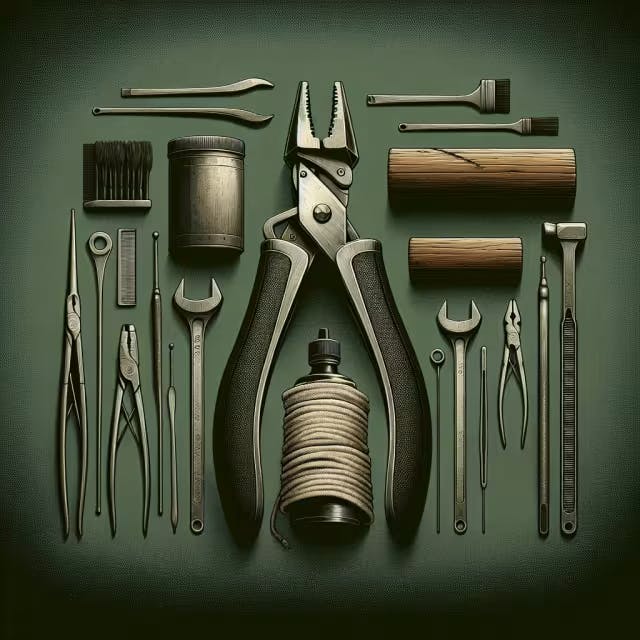
Maintaining Your Blacksmith Tongs for Longevity
Proper care ensures the longevity and effectiveness of professional blacksmith tongs. Regular inspection for signs of wear, such as cracks or weak joints, is crucial to avoid potential tool failure during a forge. To maintain their condition, periodically clean tongs to remove residue and scale buildup. Applying a light coat of oil also helps to protect them from rust and corrosion. Should tongs become misaligned or deformed, it's advised to reforge the tool to its original shape using controlled heat, taking care not to overheat or weaken the metal.
Here are some key maintenance steps to follow:
Maintenance Activity | Description |
Inspection | Check for damage or wear before and after use |
Cleaning | Regularly remove debris, scale, and clinker |
Oiling | Lightly coat with oil to prevent rust |
Storage | Keep in a dry place to avoid moisture |
Reforging | Carefully straighten or reshape when necessary |
These measures, when done consistently, will extend the lifespan of tongs, offering a better forging experience. For detailed guidance on maintaining blacksmithing tools, refer to reputable sources that provide in-depth tutorials.
Maintaining the integrity of your forging tools is essential for precision work. For those seeking additional information on blacksmith tool maintenance, The Art of Manliness provides a comprehensive guide on caring for all types of blacksmith tools, including tongs. By following these simple yet effective maintenance routines, blacksmiths can ensure both safety and quality in their craft. In conclusion, understanding professional blacksmith tongs types and uses is fundamental for any successful forging project. By choosing the appropriate tong style for the task at hand, a blacksmith ensures greater control, efficiency, and safety. Moreover, regular upkeep not only contributes to the tongs’ durability but also upholds the standard of craftsmanship, making knowledge and maintenance as crucial as the forging skills themselves.
Frequently Asked Questions
What are the different types of professional blacksmith tongs and their uses
Blacksmith tongs come in several types, each designed for specific tasks:
Flat Tongs: For holding flat sheets of metal.
Wolf Jaw Tongs: Versatile and can hold various shapes such as round, flat, and square stock.
Blade Tongs: Tailored for bladesmithing tasks to secure blades effectively.
V-Bit Bolt Tongs: Designed for a firm grip on both square and round stock.
Scroll Tongs: Suited for creating spiral shapes and intricate scroll work.
Round Tongs: Ideal for securely holding cylindrical objects like rods and pipes.
Knowing which tong to use for a specific task is essential for safety and quality in metalwork.
How do V-Bit Tongs differ from other blacksmith tongs in terms of grip and application
V-Bit Tongs, also known as Bolt Tongs, feature distinctive v-shaped jaws that provide a superior grip for round and square metal stock. Unlike Flat Tongs, which cater primarily to large, flat pieces of metal, or Wolf Jaw Tongs that offer a versatile grip for various shapes, V-Bit Tongs are specifically optimized for securely holding and manipulating both round and square workpieces. This specialization makes them particularly useful for a range of blacksmithing tasks where precise control over the stock is needed, without the risk of the metal slipping or turning within the grip.
What are Wolf Jaw Tongs and why are they considered versatile
Wolf Jaw Tongs are a type of blacksmith tong known for their exceptional versatility in the forge. They feature multiple gripping points within the same pair of jaws, enabling them to securely grasp various shapes and sizes of metal, including flat, round, and square stock. This adaptability allows blacksmiths to work on different projects without the need to change tools frequently, making Wolf Jaw Tongs an indispensable tool in any blacksmithing workshop.
In what scenarios are Blade Tongs the preferred choice for blacksmiths
Blade Tongs are the preferred choice for blacksmiths in the following scenarios:
When engaging in bladesmithing tasks, as they are crafted to securely hold blades during the forging process and allow for detailed work.
If preserving the blade's integrity and shape is essential, since Blade Tongs offer a secure grip without distorting the metal.
For work that requires attention to fine details on blades, such as beveling or shaping the spine, where precision handling is critical.
How do blacksmiths use Scroll Tongs for intricate metalwork
Scroll Tongs are used by blacksmiths to handle and manipulate smaller and more delicate pieces of metal, especially when creating scrolls or other intricate shapes. These tongs have long, tapered, and often curved jaws that provide the precision needed for bending and shaping metal without marring the surface. By offering enhanced control, scroll tongs allow for the creation of complex designs with a high level of detail and accuracy.
What maintenance practices are recommended for professional blacksmith tongs to ensure longevity and effectiveness
Regular maintenance of professional blacksmith tongs is essential to ensure their longevity and effectiveness in the forge. Here are some recommended practices:
Inspect Your Tongs Regularly: Examine your tongs for signs of wear or damage, such as cracks, weak joints, or deformation each time before using them. After intense use or when exposed to extreme temperatures, this is especially important.
Clean Tongs After Use: Remove buildup of scale, residue, or clinker. This not only keeps your tongs functioning properly but also prevents the transfer of impurities back onto your workpiece.
Apply Protective Coatings: To prevent rust and corrosion, lightly oil your tongs periodically. Use oil suited for high temperatures and metal tools.
Reforging/Misalignment Correction: If your tongs become bent or misaligned, reforge them back to their original shape under controlled heat. Avoid overheating, which can weaken the metal and ensure you follow proper blacksmithing techniques for best results.
Proper Storage: Store your tongs in a dry, cool place to avoid moisture that can lead to rust.
For further guidance on tool maintenance, detailed resources such as The Art of Manliness and The Crucible provide comprehensive information for blacksmiths, including the care of specific tong types such as wolf jaw, v-bit, or flat tongs.


